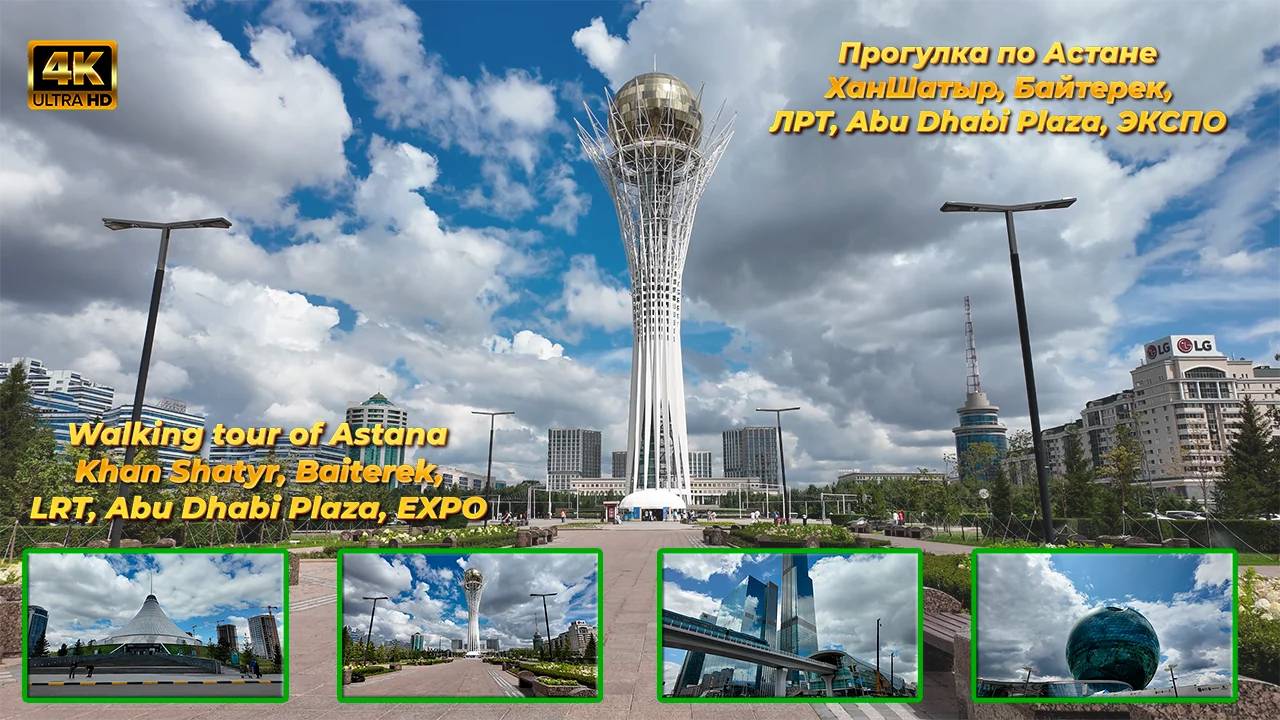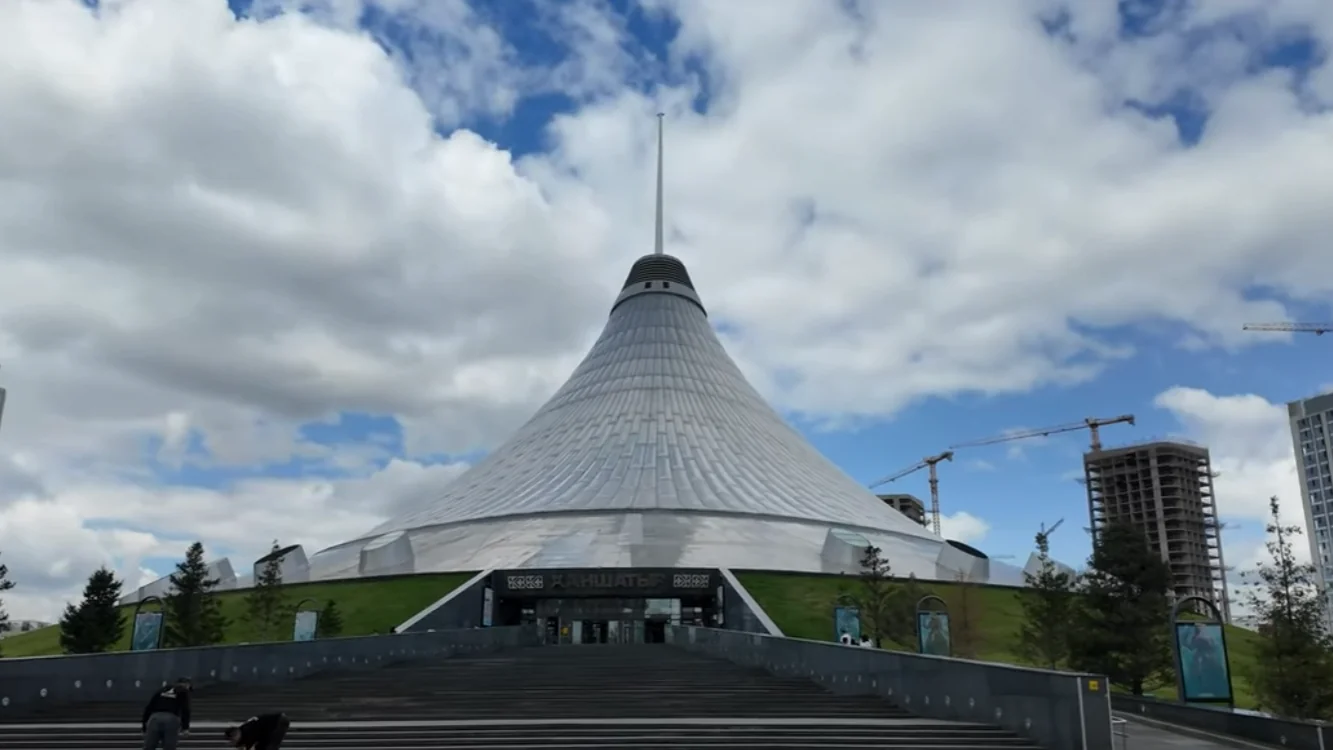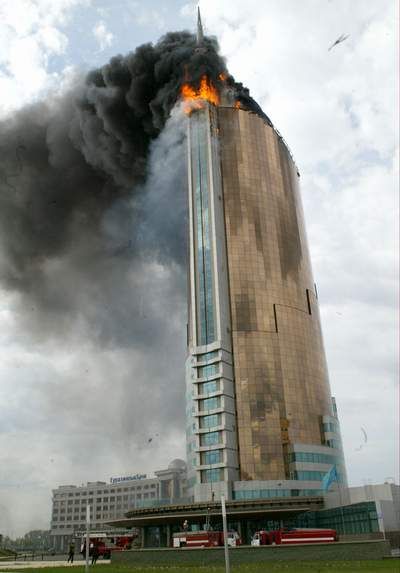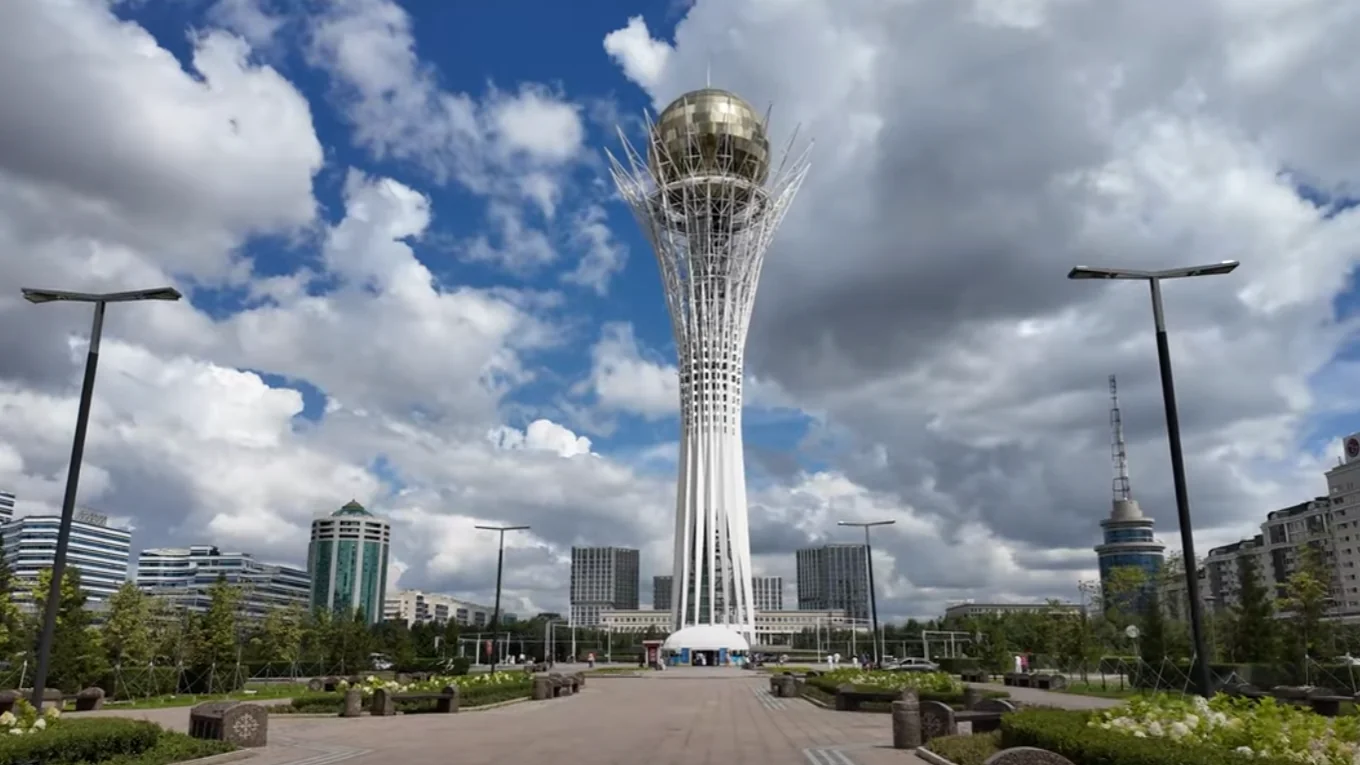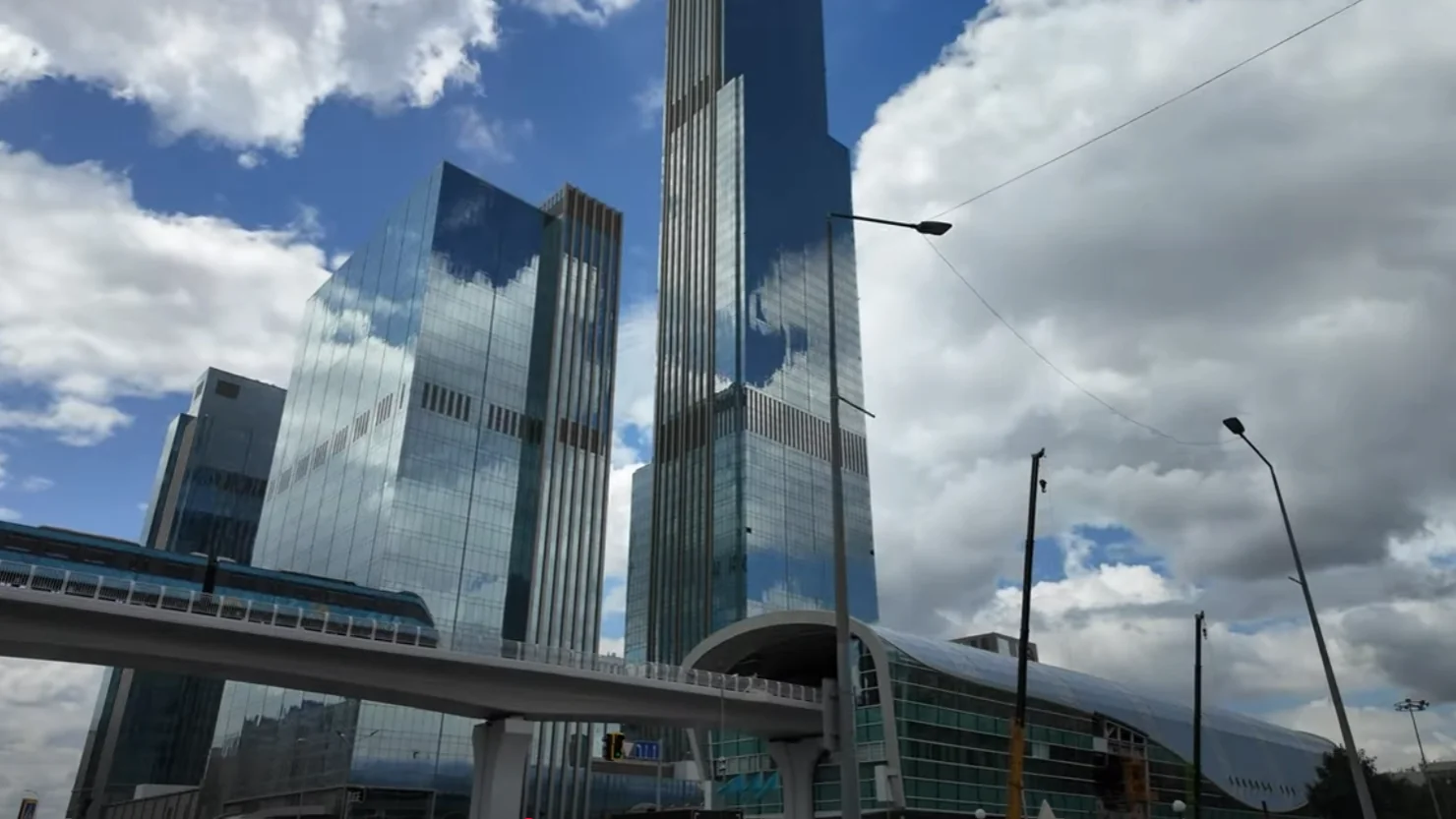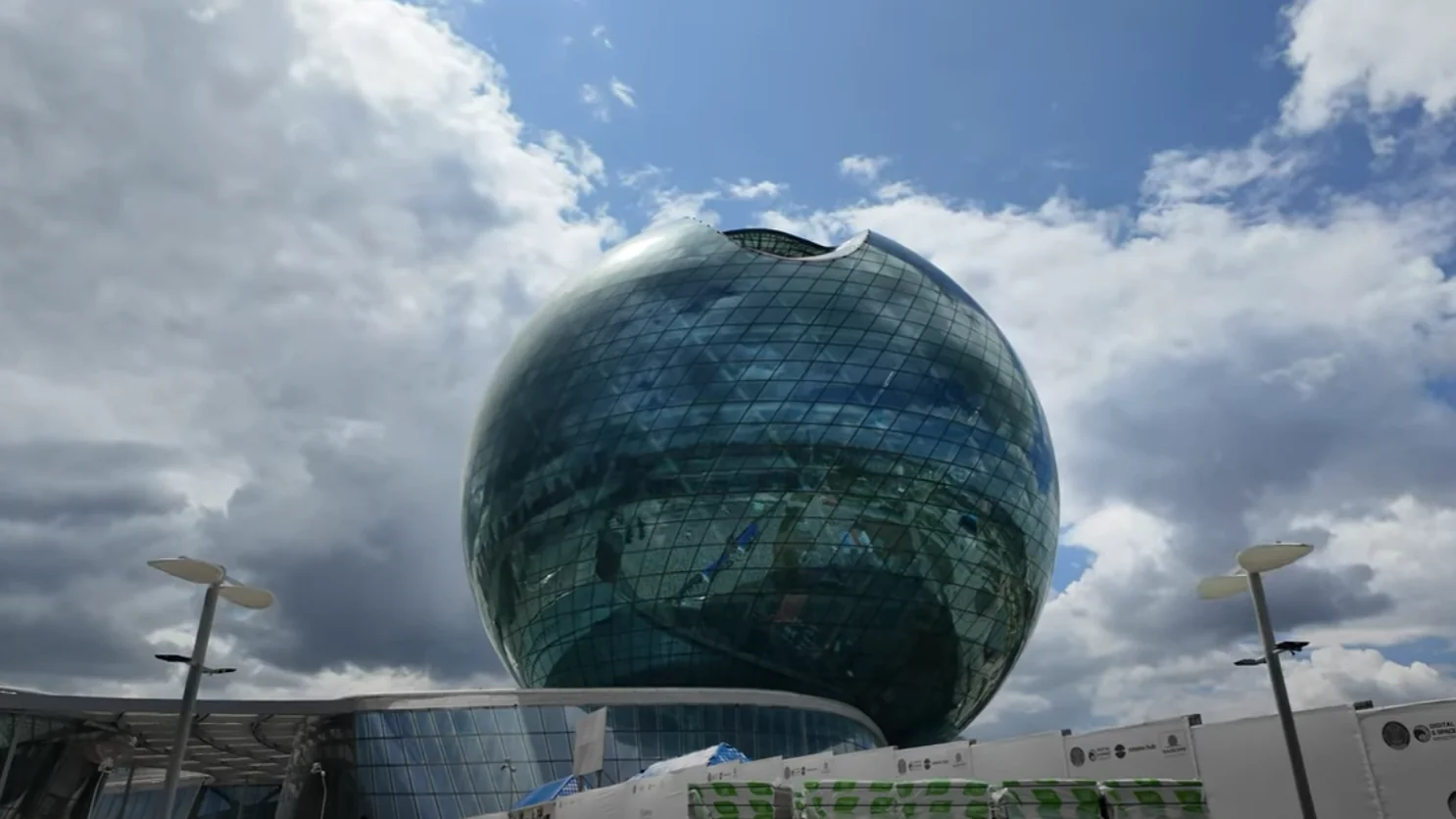🌆 Walking Tour Through the Colorful Sights of Astana
Fluffy cumulus clouds, a magnificent blue sky, and Astana’s signature wind are all included!
Today, we’re setting out on a walk through the main attractions of Kazakhstan’s capital. Our route will take us through the most beautiful and iconic locations – from Khan Shatyr to EXPO.
🕔 00:05 – Khan Shatyr Mall
We begin our walk at Khan Shatyr Mall.
This unique building, shaped like a giant tent, has become one of the main symbols of modern Astana. The project was designed by the famous British architect Norman Foster.
It was officially opened on July 5, 2010, in celebration of the Capital City Day.
The structure reaches a height of 150 meters and covers about 127,000 square meters. Inside, you’ll find shopping galleries, restaurants, a cinema, amusement attractions, and even a beach with artificial sand brought from the Maldives.
Khan Shatyr was conceived as a “city under a dome” – a place where residents can relax regardless of the city’s harsh climate.
💑 02:11 – Sculpture Composition “My Happiness”
Next to Khan Shatyr stands the romantic bronze composition “My Happiness”, depicting a couple in love.
The sculpture serves as the symbolic gateway to the Lovers’ Park and represents one of the most beautiful human emotions – love itself.
The composition is surrounded by a picturesque landscape, perfect for leisurely walks. The park covers about 14 hectares, with more than 3,000 young trees planted across its grounds.
Date of unveiling: June 10, 2005
Author: Architect T. Yerbolat
💦 03:05 – Fountain
Our next stop is one of the fountains located along Astana’s central avenues.
The city is famous for its network of fountains, which symbolize movement, energy, and the rhythm of urban life. In summer, these fountains are among the most pleasant places to relax — the cool streams of water refresh the air and bring a sense of comfort amid the city’s concrete avenues.
A particularly unique fountain, shaped like sixteen horseshoes, stands in Lovers’ Park, one of the most romantic spots in Astana.
The fountain symbolizes four horses galloping in different directions, representing Kazakhstan’s openness to the world and its dynamic development in all directions.
The horseshoes are made of stainless steel, so the beloved tradition of throwing a coin for luck might not be the best idea here — it could cause corrosion.
All the horseshoes are mounted on a symbolic wheel, signifying the unity of nations moving forward together.
Date of opening: 2007
Author: Sculptor Gabriela von Habsburg
👠 07:33 – Sculpture “The Girl Running Late for a Date”
Along our route, we come across another remarkable sculpture – “The Girl Running Late for a Date.”
The bronze figure of a young woman in motion, with a flowing scarf and a phone in her hand, perfectly captures the pace of modern Astana, where everyone is constantly on the move — chasing meetings, ambitions, and, of course, the ever-present city wind.
This sculpture has become a symbolic representation of the dynamic, confident, and independent women of Astana.
💧 08:01 – Fountain Square
Here we find Fountain Square – one of the most picturesque spots in the heart of the city.
The square is designed as an ensemble of several cascading fountains that look especially beautiful in the evening when the illumination comes on.
At its center lies the Round Square Fountain, the main feature of this architectural composition and a key element of the entire recreational area.
The fountain is designed as a flat bowl with multiple jets positioned along the perimeter. These nozzles alternate their modes, creating dynamic water patterns.
Streams of water form a graceful dome, and in its center rises a powerful geyser fountain.
This is always a lively place, where locals and visitors gather to relax. In the evening, when the LED lights turn on, the fountain becomes a mesmerizing spectacle of color, light, and motion.
🏢 09:01 – Ministry of Transport Building (“The Lighter”)
Not far from here rises the modern Ministry of Transport and Communications of the Republic of Kazakhstan, known among locals by its informal nickname – “The Lighter.”
The reason is simple: its tall, vertical shape and silver façade panels resemble a gas lighter.
This nickname became even more firmly associated with the building after a fire on May 30, 2006.
According to official reports, no one was injured. However, firefighters initially struggled to contain the blaze – their ladders turned out to be too short to reach the upper floors.
Falling fragments of the façade caused the lobby on the first floor to catch fire as well. It took about two hours to completely extinguish the flames.
The building was constructed in the early 2000s and serves as a classic example of the architectural style that defined the early development of Kazakhstan’s new capital.
🚉 13:27 – “Kazakhstan Temir Zholy” Buildings and “Emerald” Business Center
Next, we see the administrative complex of “Kazakhstan Temir Zholy” – the headquarters of the national railway company of Kazakhstan.
Right beside it stands the “Emerald” Business Center, an elegant modern building with panoramic glass façades.
This district is considered the core of Astana’s transport and business infrastructure, bringing together major logistics and administrative institutions of the capital.
🌌 14:36 – Residential Complex “Northern Lights”
“Northern Lights” is one of the most recognizable residential complexes in Astana.
Its three towers seem to mirror the dance of the aurora borealis, and from the upper floors, residents enjoy breathtaking views of Bayterek.
The architecture combines glass and metal, emphasizing the city’s northern character and modern style.
🌿 18:57 – Green Water Boulevard
This is the central pedestrian axis of the city. The Green Water Boulevard connects Khan Shatyr with the square near the Aq Orda Presidential Palace.
Its development began in 2008, and today it serves as the venue for festivals, fairs, and city celebrations.
The boulevard is beautifully landscaped with trees, flowerbeds, and contemporary sculptures.
Right nearby stands the Business Center “On the Green Water Boulevard”, home to the offices of major national and international companies.
🏬 19:19 – Keruen Shopping Mall
The Keruen Mall opened in 2006 and became the first major shopping center on the city’s left bank.
The name “Keruen” translates to “Caravan,” symbolizing journey and cultural exchange.
Today, it remains one of the main leisure and shopping destinations for both residents and visitors of Astana.
📚 19:25 – National Archive of the Republic of Kazakhstan
The National Archive opened in 2006. It houses over one million unique documents that reflect the history of Kazakhstan — from the era of the Kazakh Khanate to the present day.
The building’s architecture follows a strict, modern style, symbolizing reliability, preservation, and the continuity of national memory.
🌳 21:16 – Baiterek Monument
Without a doubt, Baiterek is the main architectural landmark of Astana.
The monument was erected as a symbol of Kazakhstan’s capital relocation from Almaty to Astana in 1997.
Standing 105 meters tall, the structure rises above a wide, elevated square. It consists of a narrow cylindrical shaft surrounded by white beams resembling tree branches that spread upward to support a golden mirrored sphere with a diameter of 22 meters.
At the base, there is a ticket office and an exhibition area. Inside the shaft, two elevators take visitors up to an observation deck located inside the “egg.” The entrances to the monument are slightly below ground level and can be reached by staircases leading from the surrounding plaza.
The observation deck, situated 97 meters above the ground, features two levels.
On the lower level, visitors can enjoy a 360-degree panoramic view of Astana and its surroundings, while the upper level is accessed by a small staircase.
At the very top stands a gilded imprint of the right hand of Nursultan Nazarbayev, the First President of independent Kazakhstan, mounted on an ornate pedestal. A plaque invites visitors to place their hand on the imprint and make a wish.
Nearby, facing the Presidential Palace, is a wooden sculpture in the shape of a globe with sixteen radiating beams — a symbol dedicated to the Congress of Leaders of World and Traditional Religions, which has been held in Astana several times.
🏙️ 22:41 – Panoramic View of Talan Towers and Abu Dhabi Plaza
On the horizon, two architectural giants dominate the skyline – Talan Towers and Abu Dhabi Plaza.
Talan Towers
Talan Towers is a premium mixed-use complex located in the heart of Astana.
It consists of a podium and two towers that house office spaces, retail galleries, a luxury hotel, and residential apartments.
The 30-story Talan Towers Offices building serves as a business center, while the 25-story tower accommodates The Ritz-Carlton Hotel and high-end residences.
The two towers are connected by a shopping gallery, and the total floor area of the complex is approximately 106,194 square meters.
Commissioned by the Verny Capital Group of Companies, Talan Towers officially opened in 2017 and quickly became one of the city’s architectural landmarks.
Abu Dhabi Plaza
Abu Dhabi Plaza is a multifunctional complex located in the very center of Astana.
As of 2022, its tallest tower — standing at 310.8 meters (1,020 feet) — holds the title of the tallest building in Kazakhstan and all of Central Asia.
The complex includes residential apartments, offices, retail spaces, and a hotel, symbolizing Astana’s growing partnership with the United Arab Emirates and its ambition to become a modern, global metropolis.
🚉 31:51 – Astana LRT Train and Station
The Light Rail Transit (LRT) is one of Astana’s most ambitious urban transport projects, launched in 2011.
The planned 22.4-kilometer line with 18 stations will connect Astana International Airport with the Nurly Zhol Railway Station located in the city center.
A total of 18 four-car trains will operate on the route, with deliveries expected to be completed by December 2025.
As of September 29, 2025, Astana began operational testing of the elevated LRT line to verify the technical readiness of its infrastructure, control systems, and driverless trains supplied by the Chinese corporation CRRC.
If the trials are successful, the line is expected to open for public service in the first quarter of 2026.
The LRT stations feature futuristic designs with glass-covered platforms that blend modern architecture with practicality.
Despite construction delays, the LRT has already become a symbol of Astana’s modernization and its vision for a sustainable, future-oriented transportation system.
🌤️ Conclusion
Thus ends our walking tour through the most iconic landmarks of Astana.
We’ve traveled from the legendary Khan Shatyr to the shining domes of EXPO, witnessed both old and modern architecture, explored the city’s symbols, and felt the unique spirit of the capital — energetic, windy, and deeply inspiring.
If you haven’t visited Astana yet, be sure to come and see for yourself how the future is being born amid the vast Kazakh steppe. 🌤️
Watch a walking tour of the colorful places of Astana – Khan Shatyr, Baiterek, LRT, Abu Dhabi Plaza, EXPO

